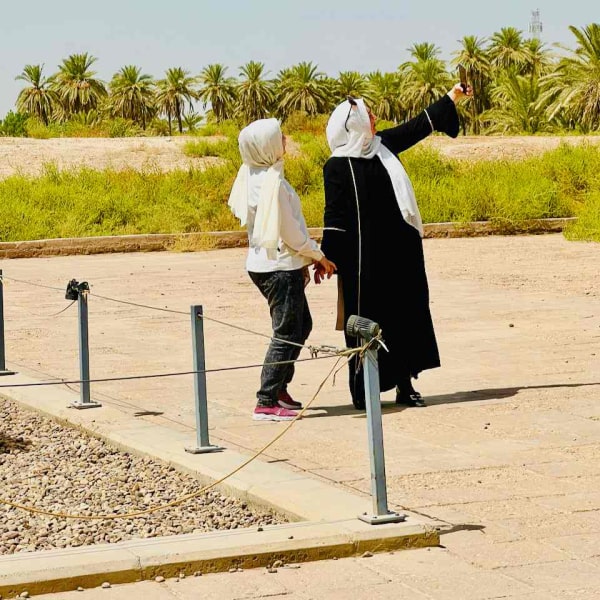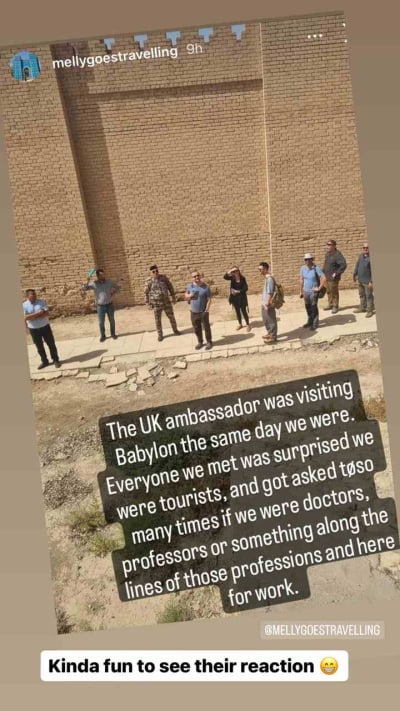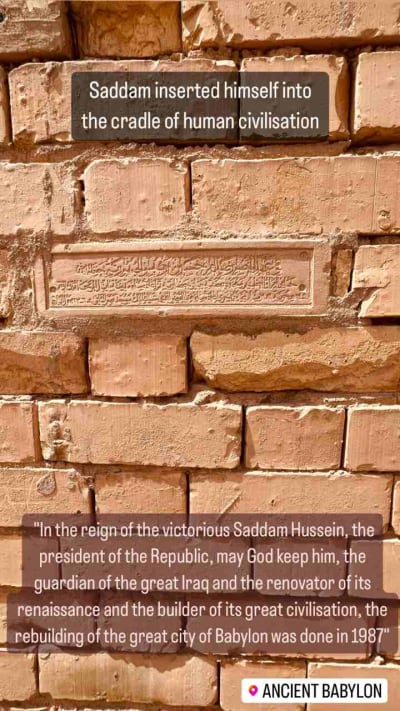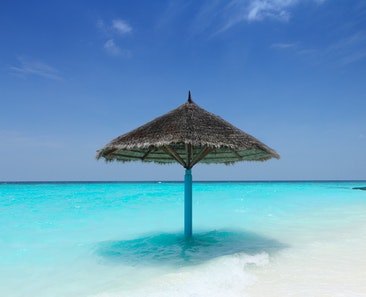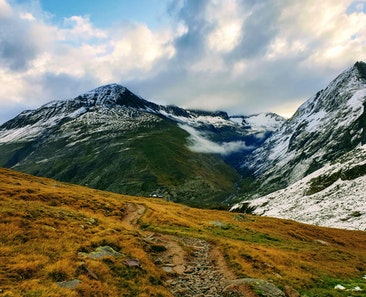3 days in Iraq: Exploring Babylon
Onwards to Babylon
It’s Day 2 in Iraq: Up bright and early(ish), and super excited for the day ahead: We leave Baghdad behind for now, and travel 85 km south – to Babylon. We will be visiting the 4,000-year-old city, have a look inside Saddam Hussein’s massive palace, and take a boat trip on the Euphrates. Mel has two bucket list items on the agenda for today: 1. Sit in Saddam’s bathtub, and 2. Listen to Boney M while sailing on the Rivers of Babylon.

Ancient Babylon and Saddam Hussein’s palace
Silicon Valley has nothing on Babylon
Babylon! It is one of those great names, isn’t it, evoking a sense of fairytale and mystery. A name that could be out of Arabian Nights. Right up there with Samarkand and Kashgar. And Baghdad, too. It means Gate of the Gods.
Babylon is an enduring testament to human ingenuity and ambition. Thousands of years ago, some serious innovation was taking place here, laying the foundation for so much of what we take for granted today. Let’s take this post here: I am writing it using html. Tim Berners-Lee, brilliant scientist that he is, could not have invented html if the Babylonians had not invented writing in the first place.
The same with science and mathematics. Algebra was first developed here. As was the base-60 numeral system, which we still use to measure time and angles. Think about that, the next time you do a 360.
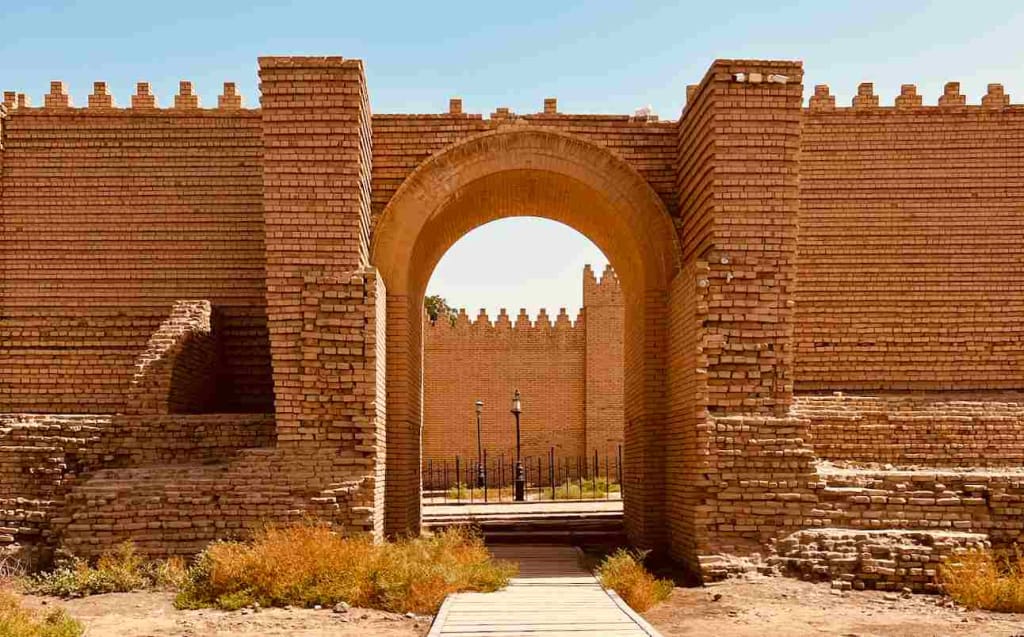
And literature? You will have heard about Gilgamesh. From the 2nd century BCE, this epic is one of the earliest works of fiction we know, pre-dating the Old Testament by ca. 1,000 years. Gilgamesh, the protagonist, leaves his home to go walkabout with his buddy Enkidu, who sadly dies midway. Continuing on, Gilgamesh meets the legendary survivor of the great flood, Utanapishtim. Sound familiar?
Here is a verse from that Babylonian story that I like. Just plain good advice, don’t you think?
As for you, Gilgamesh, let your belly be full,
Make merry day and night.
Of each day make a feast of rejoicing.
Day and night dance and play!
Let your garments be sparkling fresh,
Your head be washed; bathe in water.
Pay heed to a little one that holds on to your hand,
Let a spouse delight in your bosom.
There is a parallel (but not as delightful) in the Bible (Ecclisiastes 9:7-9). You can read more about Gilgamesh and its influence on biblical authors here.
Welcome to Babylon
Ancient Babylon has been through a lot in modern times: massive reconstruction by a megalomaniac dictator in the 1980s, and American occupation in the 2000s. Only 18% is excavated, but even that is in danger from aggressive development, not least with an oil pipeline running underneath the outer walls.
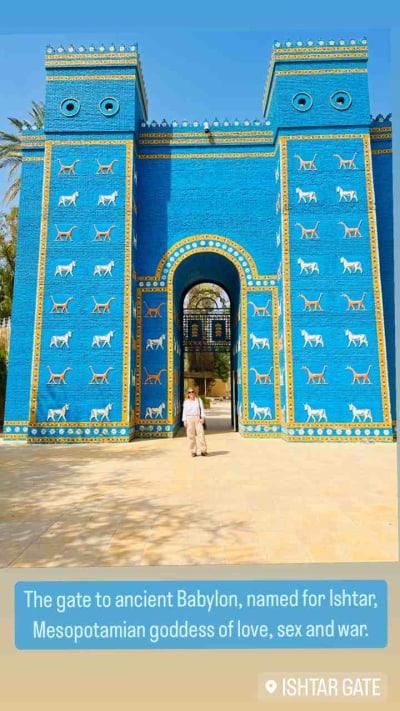
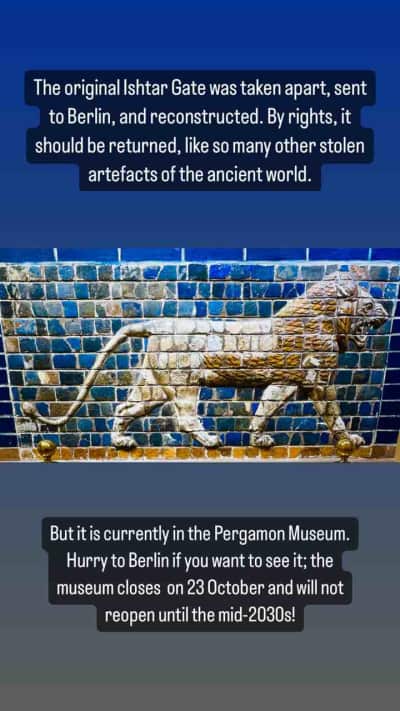
Our exploration begins at the Ishtar Gate. A replica, admittedly. Still, it gives us a good idea of how this majestic masterpiece must have looked up close in ancient times.
The Hanging Gardens of Babylon
Inside the gate is a map, showing how the ancient city looked. How it most likely will have looked, that is.
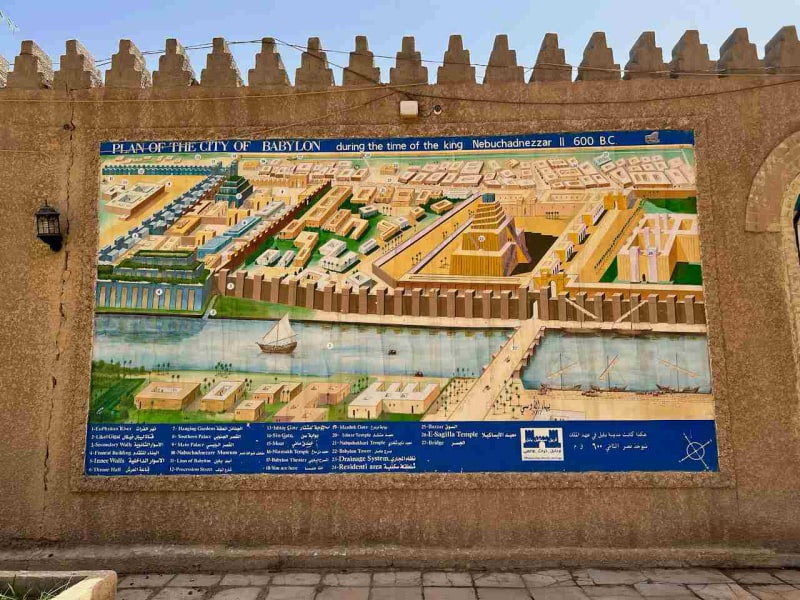
A highlight back in those days, must surely have been the Hanging Gardens, one of the 7 Wonders of the World. Thing is, of those 7, this is the only one where a definite location cannot be determined. According to the map above, the Hanging Gardens would have been located at no 7, the green building up left. I’m wondering, though: it can’t have been easy to maintain all that lush greenery in this desert environment. Wouldn’t no 4 (bigger building, further down on the left) be a more logical location? Next to the river, easier to irrigate?
Speculation about the location aside, we have to ask, don’t we – did they even exist, these exotic gardens – or is it just a romantic myth? There is not much archaeological evidence. Of course, that question could be asked about some of the other 7 world wonders, too. The only one we know for sure did exist, is the only one still standing: the Great Pyramid at Giza.
A Babylonian priest was the first to describe the Hanging Gardens:
… he erected very high walls, supported by stone pillars; and by planting what was called a pensile paradise, and replenishing it with all sorts of trees, he rendered the prospect an exact resemblance of a mountainous country. This he did to gratify his queen, because she had been brought up in Media, and was fond of a mountainous situation.
Berossus, ca 290 BCE
*he, being King Nebuchadnezzar II (605 – 562 BCE). Amytis, his queen, was from Media, a region comprising present-day Azerbaijan, Iranian Kurdistan, and the northern part of Dagestan. It’s a a sweet story, isn’t it? I hope it’s true.
Here is an unknown 19th century artist’s idea of how the Hanging Gardens might have looked:
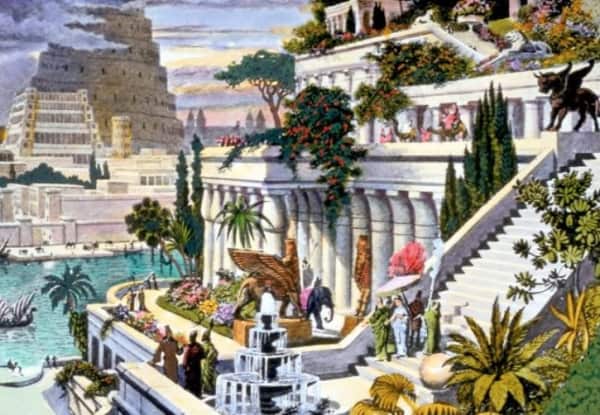
By Unknown author – Public Domain
The Tower of Babel
In the background is the Tower of Babel. Remember that story?
All the world spoke one language. Things were going well, so the people decided to build a city in Babylonia. ‘And while we’re at it, let’s build a tower, too,’ they said. ‘A really high one. And make a name for ourselves.’ But God was none too pleased at their self-confidence, so he said: ‘If they do that, nothing will be impossible for them. Come, let Us go down and confuse their language, so they don’t understand each other anymore. Then we’ll send them abroad over the face of all the earth.’ (Genesis 11:1-9).
And just a reminder that this was not too long after he had killed off everyone but one family in the great flood I touched upon above here. Even the animals were left to drown. What a guy, eh?
Back in real world Babylon
OK, bit of a digression to fantasy land there. Hanging gardens and babbling towers is obviously not something you can see in present-day Babylon, outside of your creative thinking, that is. Have to say though, being here, walking where the gardens might have been, certainly fires up the imagination. But we’d best stick with the real, tangible present. The Ancient Babylon you can actually touch. Like this clay tablet here:
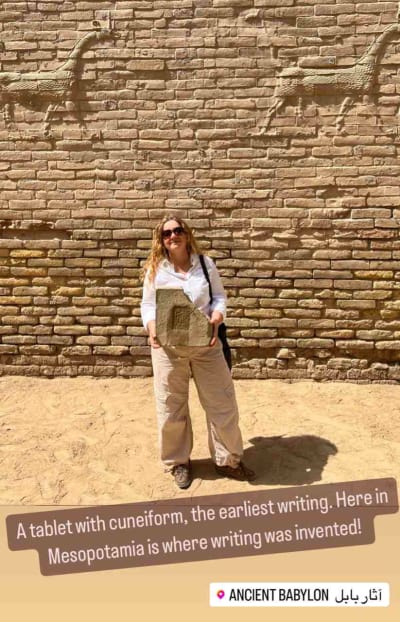
… found just inside the 8th inner gate, i.e. the Ishtar Gate:
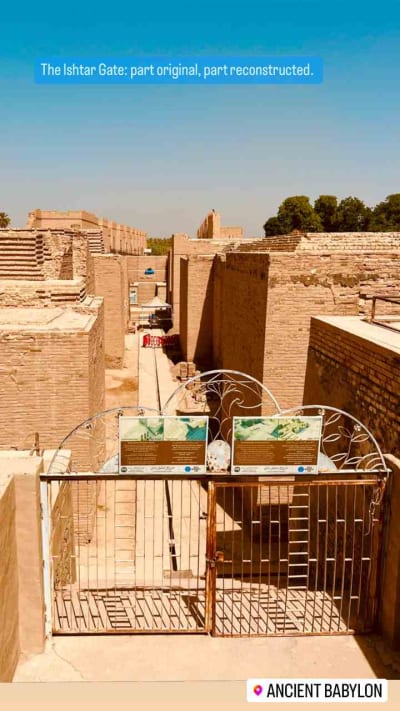
None of the intricate glazed blue tiles left here, sadly
Tourism in Babylon

The 2,600-year old Lion of Babylon, national symbol of Iraq. See the man under it? Lion’s da boss.
Babylon is not overrun with tourists.
As you can see, we are not the only ones exactly –
– but in a way, we also are.
Ancient Babylon must have been a wealthy and powerful city. We continue our walk along the Street of Procession, between the impressive walls, wide enough to drive a four-horse chariot along the tops, according to legend.
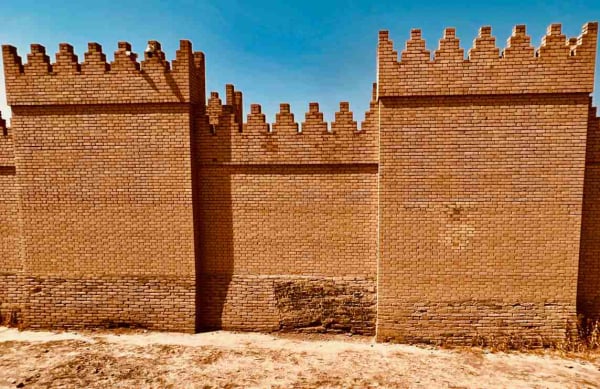
At the bottom is the ancient part of the wall, on top is the reconstructed part
Saddam Hussein, part II
As we pass through the vast labyrinth that is the ancient city, this appears on a wall:
Apparently, Saddam was obsessed with Nebuchadnezzar, builder of the great Babylonian civilisation (and a bit of a war monger himself). In fact, he saw himself as the reincarnation of the ancient king, and set about reconstructing Babylon.
Great civilisation builders must have palaces, of course, preferably overlooking their chef d’oeuvre. So Saddam had one built here in Babylon, all Sumerian ziggurat style, next to Nebuchadnezzar’s palace. Never mind the obliteration of Qawarish, the little village that once stood in this place.
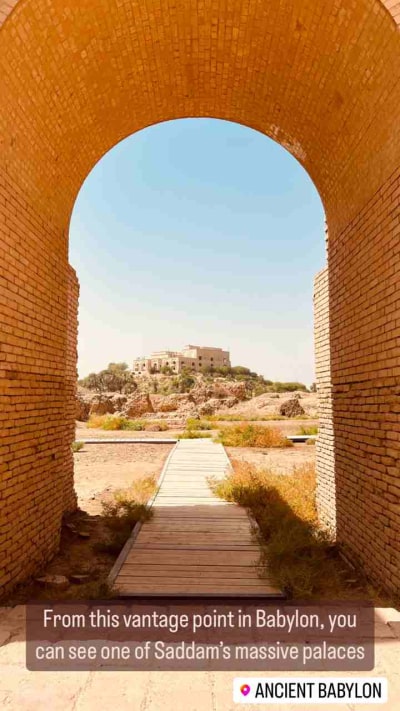
A little bit closer:
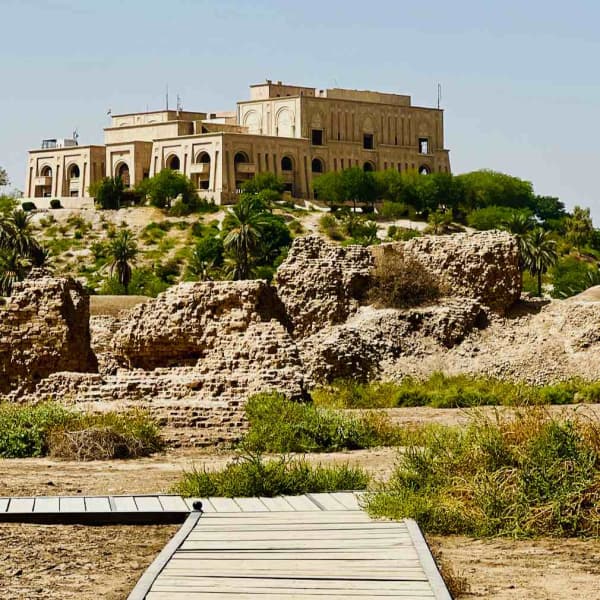
Let’s go and find that bathtub.
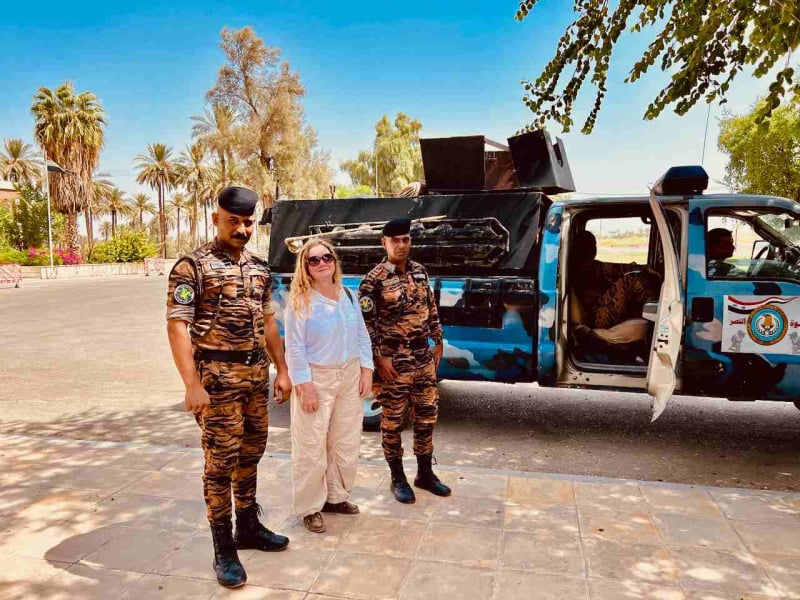
We leave through the replica Ishtar Gate and say goodbye to the friendly guards outside.
Wanna play ‘Spot Saddam’?
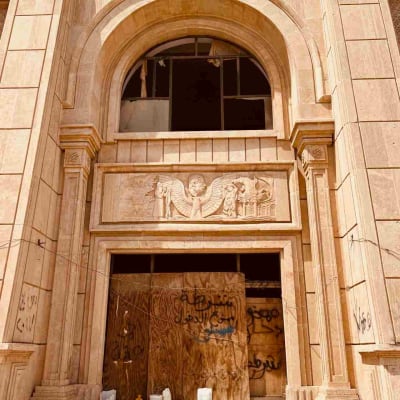
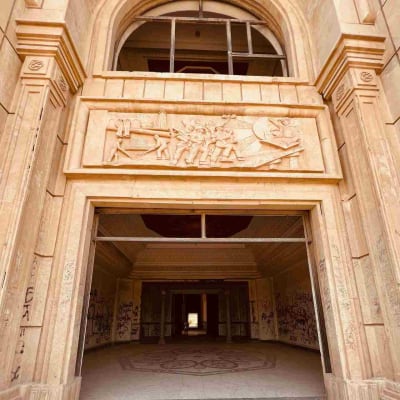
In case anyone forgets whose palace this is was, the reliefs above the entrances leave little doubt.
Must have been quite the sight in its glory days:

Today, you will see faded grandeur…
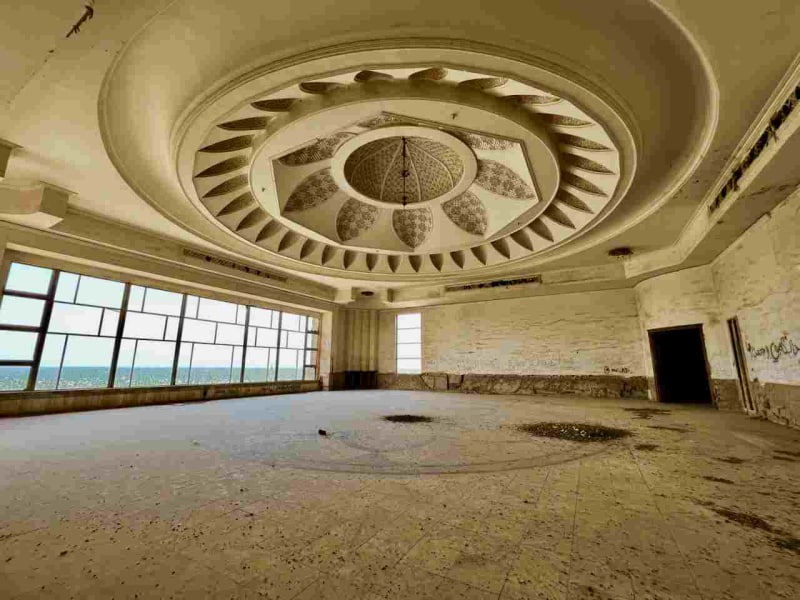
… tagging, dust and dirt…

… and barbed wire.
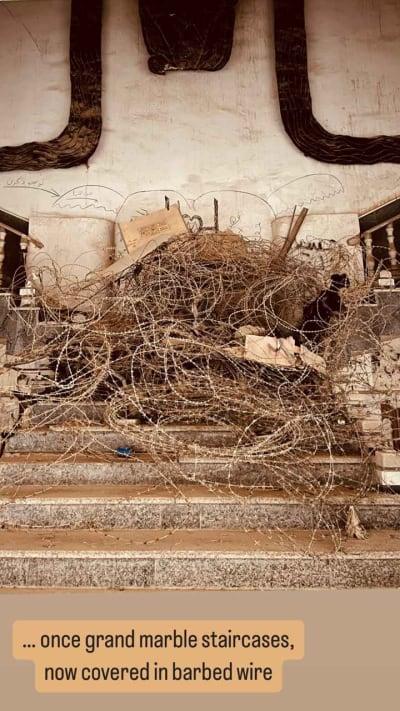
Saddam had fabulous views:
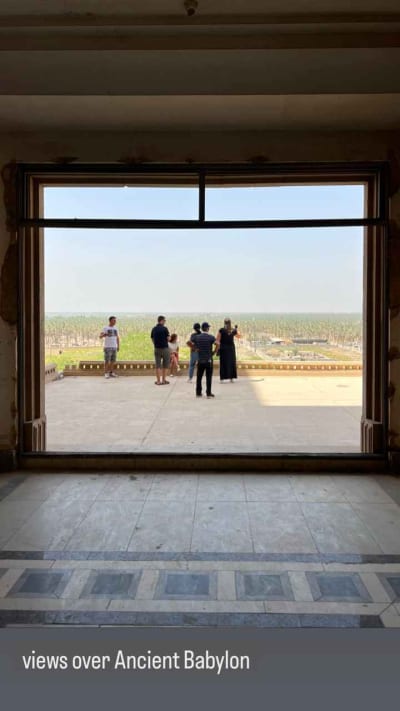
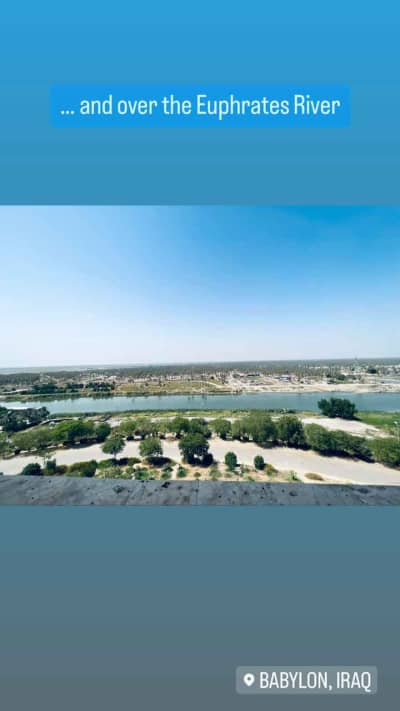
And now – what you have been waiting for:

This is one filthy bathtub. What I won’t go through for a photo op.
And here is the lovely Lina testing Saddam’s shower:

On the rivers of Babylon
Wandering inside Saddam Hussein’s abandoned palace! Sitting in Saddam’s bathtub! That’s some life changing experiences right there. Hard to beat. But let’s try anyway.
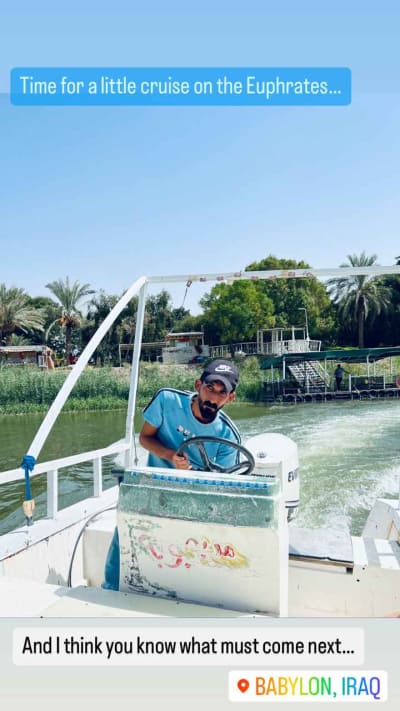
On the River Euphrates, of historical (and biblical) fame.


Ellen and Melissa rockin’ it to Boney M
Meanwhile, along the river banks, life goes on pretty much as it has for 4,000 years.

Moving on
Onward once again, towards interesting, yet challenging places. We are going to Karbala, where we will spend the night. Time to dig out the abayas. Time to cover up and hide anything even remotely feminine, such as a strand of hair. Or a fleeting glimpse of an ankle.
Next up: the holy cities of Karbala and Najaf. Stay tuned.
All photos by Melissa G. Mitruen, Ellen Sjølie, David Røgler, Lina Røgler, and myself.
3 Days in Iraq part I: Baghdad.

Babylon is a UNESCO World Heritage site.
Here are more UNESCO World Heritage sites around the world.
3 days in Iraq: Exploring Babylon is a post from Sophie's World

